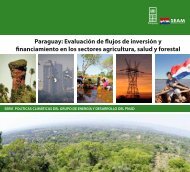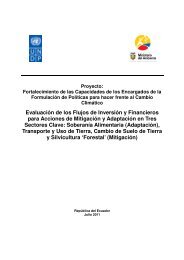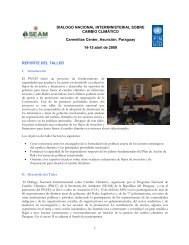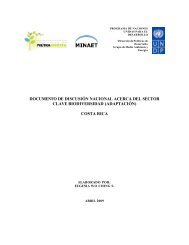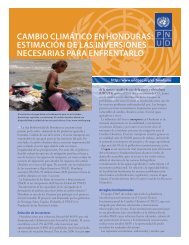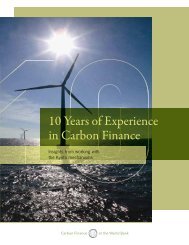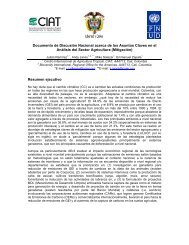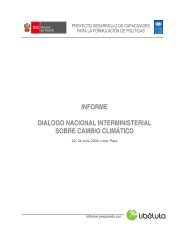national climate change awareness-raising workshop - UNDPCC.org
national climate change awareness-raising workshop - UNDPCC.org
national climate change awareness-raising workshop - UNDPCC.org
You also want an ePaper? Increase the reach of your titles
YUMPU automatically turns print PDFs into web optimized ePapers that Google loves.
• Provide guidance on how to conduct the actual assessment of I&F flows, while also being a flexible<br />
process that <strong>national</strong> teams can use to better understand the investment and financial implications of<br />
<strong>national</strong> <strong>climate</strong> <strong>change</strong> mitigation and adaptation strategies.<br />
A presentation was also provided on the key elements of the methodology for assessing I&F flows (see full<br />
presentation attached). Participants then discussed the kind of data needed and where to find it, how to<br />
access and evaluate the data, how to set boundaries for the sector (i.e. only electricity or the entire energy<br />
sector), scenario development for the mitigation and adaptation scenarios, and ways to model the information.<br />
It was noted that technical backstopping would be provided for supporting the production of the analysis. An<br />
additional weeklong training may also be necessary. Key pre-requisites for the assessment will be: identifying<br />
the project team and assigning roles, clearly understanding the methodology, and defining the scope of each<br />
sector to be assessed.<br />
Mitigation scenario–Energy<br />
Participants discussed the five steps for the assessment—scoping out the effort, establishing the reference<br />
scenario, establishing the mitigation scenario, estimating incremental investment flows, and synthesizing<br />
results. In a sample mitigation scenario, a reasonable attempt to add <strong>climate</strong> measures might be to increase<br />
the percentage of energy received from solar or diesel (which is cleaner than coal). This would fulfil <strong>national</strong><br />
development aspects and address <strong>climate</strong> <strong>change</strong>. The resulting synthesis should include a summary that<br />
provides the highlights of the broader picture followed by a detailed technical report that spells out the<br />
assumptions and data used for arriving at numbers.<br />
In the discussion, participants noted that possible data sources could include:<br />
• National household income and expenditure surveys;<br />
• Energy sector reviews;<br />
• National resource accounts;<br />
• Studies under the Namibia Renewable Energy Programme.<br />
Possible institutions that may have useful data include:<br />
• Governmental bodies, such as the Ministry of Environment and Tourism, which has been involved<br />
with the <strong>national</strong> communication, the Ministry of Mines and Energy, the National Planning<br />
Commission and the Ministry of Finance and the Investment Centre and possibly the Ministry of<br />
Industry and Trade;<br />
• Polytechnic of Namibia (which already has a good CDM scenario);<br />
• Non-governmental <strong>org</strong>anizations, like the Desert Research Foundation;<br />
• The Electricity Control Board;<br />
• Nampower (<strong>national</strong> power company).<br />
A <strong>national</strong> team will be created and will get funding from UNDP to undertake the assessment. The UNDP<br />
office in New York will come up with drafts based on inputs received at this <strong>workshop</strong>, as well as the recent<br />
training at the “global” <strong>workshop</strong>. An ideal team could include individuals involved in planning, financial and<br />
investment matters, and policymakers familiar with the current <strong>climate</strong> dialogue. Consultations with all<br />
<strong>org</strong>anizations will be needed to create a work programme for the assessment. It is important to involve<br />
different institutions according to their capacity.<br />
Adaptation–Land use<br />
Adaptation is a more challenging issue and work on the adaptation scenario has only begun recently. The<br />
adaptation scenario will require the same five steps and basic framework as used for mitigation, but applied to<br />
a different set of circumstances. For example, Step 1 (scoping out the effort) will require establishing a time<br />
15




